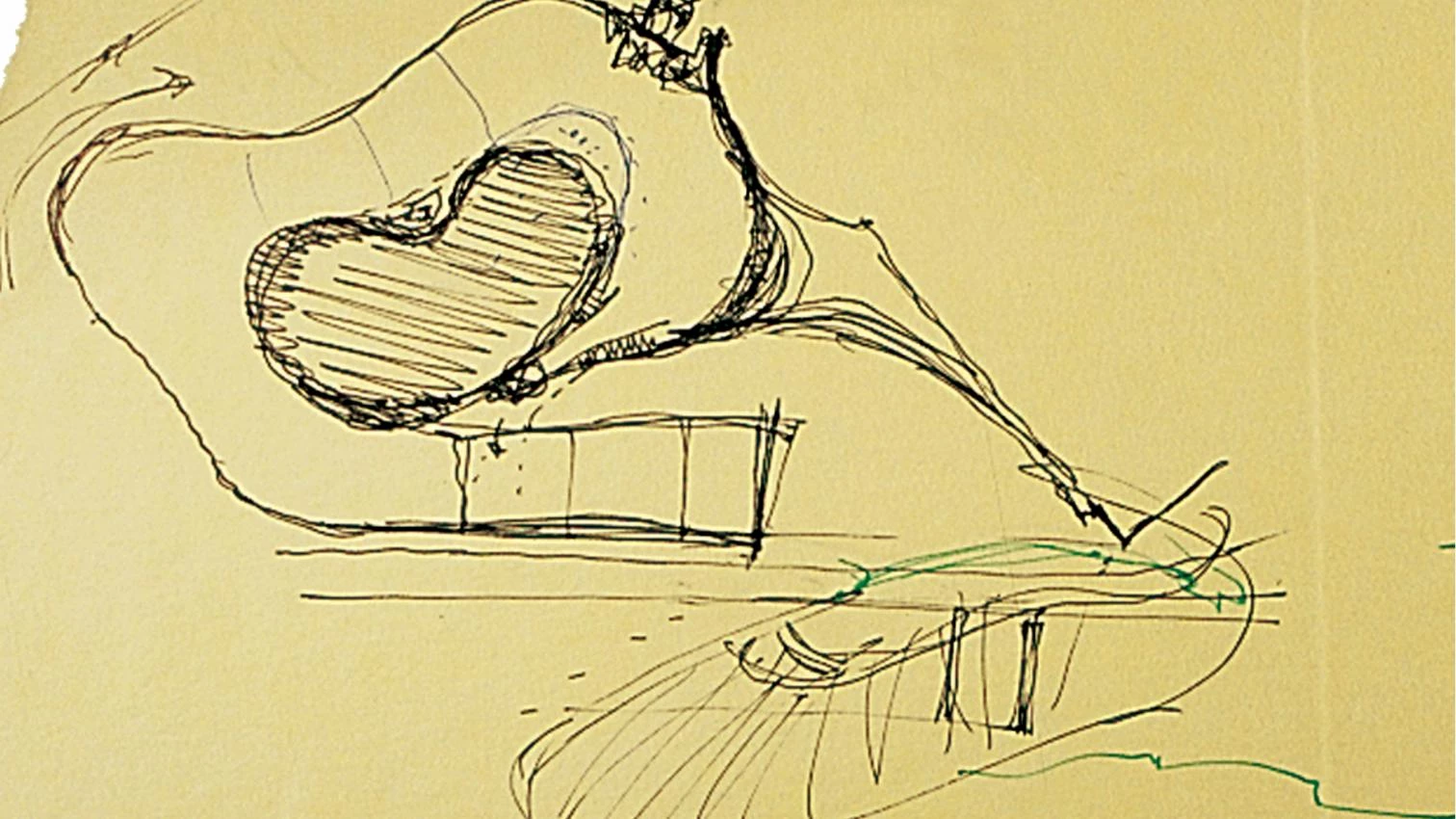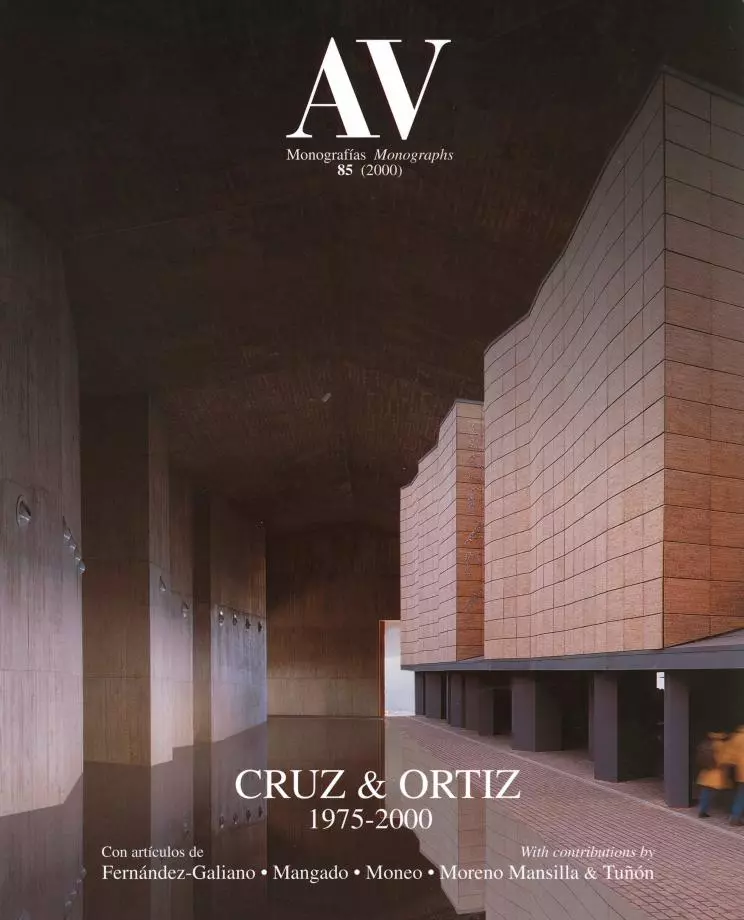Epiphany of Moment

Whoever has closely followed the work of Antonio Cruz and Antonio Ortiz, admirable for its continuity, may be surprised at the appearance, as something new in their career, of projects like their entry to the competition for the extension of the Reina Sofía, their proposal for the Solar de Caballería in Burgos, or the Spanish pavilion at Hannover. The serene mood of repose that we appreciated in much of their previous work has now been sacrificed, one might say, in the name of reflecting a fluid and malleable universe. Cruz and Ortiz are not the only ones tempted to undertake such an adventure. It has been some time since architects abandoned the orthogonal grid, and the geometry that went with it, to unfurl in space a battery of undulating structures endeavoring to represent and register movement. On the other hand, such aspirations are nothing new. When Alvar Aalto astonished the world with the rolling walls of the Finnish pavilion at the World’s Fair of New York (1939), critics spoke of Guarini’s Carignano Palace and the disturbing geometry of Borromini churches as references. Later Le Corbusier, and with him many Latin American architects, felt drawn to an architecture that took shape to the dictates of movement. But definitely it is only recently that we have come upon the latest Gehry on one hand, and those trying to transform architecture into a restless landscape on the other-all toward a way of building architecture that negates the condition of radical immobility heretofore considered consubstantial to the discipline.
But why this preamble? Isn’t the idea to identify the character of those singular works of Cruz & Ortiz to which we alluded at the start? As in other projects of theirs, what distinguishes these troubled and restless works are differences, more than similarities. The Reina Sofía project makes allusions to movement and its architectural discourse seems to insist, once again, in the promenade, which in this case-as in Frank Lloyd Wright’s Guggenheim-encourages us to carry out a pleasant descent. The museum as a place where culture provides hedonistic satisfaction seems to be present in this project. But it would be a mistake to judge the Reina Sofía extension from a strictly functional, museum-related perspective. What interests Cruz & Ortiz, apparently, is contrast. The extension is understood as a symbiosis, and the new building as an attachment that imposes no obligations. It is the epiphany of the moment that seems to be important to the Sevillian architects, an epiphany that translates into the lack of prejudices in the treatment of the roof and wall. The formal, almost graphological gesture is constructed in a conventional manner. What matters now is the gesture; in the gesture lies the force of an architecture no longer under obligation to explain the logic that supports it in compositional or constructional terms. Testifying to the moment or instant in which the architects conceived the building counts more than a structuralist discourse of the kind that tends to reconsider the mass and the lines of the old hospital through the construction of a complementary building-the annex that helps keep it on its feet. The emphasis on showing us that the buildings share only some element of vertical communication serves to confirm what these written lines affirm.
The attitude behind the Solar de Caballería project is diverse, although this, too, makes use of contrast. Hence it consciously offers the future visitor a building from which to contemplate the city and its past, and which while respecting scale and surroundings openly manifests its artificiality. Paradoxically, the artificiality manifests itself through mimesis. And by accepting it-at the risk of resembling a theme park when replicating the Atapuerca Cave-Cruz & Ortiz encountered what would be the most attractive episode of this architecture: an exploration of possibilities in the construction of a wall, through the manipulation of its thickness and shape. Transpiring between the two episodes that give life to this proposal is a fruitful dialogue-a balance, if you will, between architecture of the kind that makes its contour and perimeter its banner (the external seems to prevail here), and architecture where the internal spaces (the auditorium) define and dictate what both the volume and the structure are to be. Differences on plan-so important, so consciously established-are equalized with the roof, a sloping plane that will in the final analysis be the key element in defining the form. The interaction between the abstract plane of the roof and the exact perimeter of the floor plan results in a volume that, had it been carried out, would surely have established a definitive distance from the existing urban environs.
In the Hannover pavilion, the effort to dissolve the conventional square of a lot assigned to Spain by the Expo is manifested through a broken, fractured architecture. The difficulty inherent in the proposal comes across in the problematic transition that turns the forest of capricious polygonal pilasters into contrived paraments, where the choice of material-cork-bespeaks the architects’ desire to avoid trite roads. The complex and ambiguous system of voids that gets fenced in by the smoothly fissured cork wall gives rise to a spectacular space worthy of being considered the heart of the pavilion. The huge skylight assumes the role of metaphorical center of a universe around which all elements of architecture move: the fragments that adapt, like icebergs, to the perimeter of the square, as well as the ‘milky way’ formed by the many access-filtering pilasters. Recreating through architecture a new natural framework in which to show the now of Spanish life seems to have been the architects’ objective.
I trust that these brief notes on such singular buildings will help keep the reader from confusing the work of the Sevillian partners with that of so many other architects seduced by the undulating form, lured by a world Anglo-Saxon critics call ‘formless’. This said, we nevertheless have to admit that these buildings do indicate a disturbing change of direction in their career. I daresay that in all these projects there is a shift in the architect-architecture relationship, whereby the object comes to have priority over the subject. Or, in other words, all responsibility over form is now transferred to the work. The annex to the Reina Sofía, the mineral fragment of the Solar de Caballería and the microcosmos at Hannover are, above all, buildings whose physical condition as objects is not only present, but also predominant. The Reina Sofía project, given the symbiotic condition of the new building, has the character of an object and the character of nature at the same time; we would like to hold the model of the Burgos project in our hands in order to feel its weight, just as if it were a mineral; and the Hannover pavilion immediately bring to mind certain architectural objects that are so famous they need not be mentioned. That these projects are about architecture with a life of its own (hence our talking about objects) is, in my opinion, evident.
Such an attitude differs much from that of many architects today who, in the name of fluidity, seek to forget that buildings are objects, and go on to reduce architecture to a field in which to proceed-or to a mere landscape, if you will. Recognizing the value of the individuality of buildings becomes, for the Sevillian duo, a challenge that leads them to explore the unknown, and constitutes, as I was saying, a change of course in their career, one that must be assessed for its merits. Especially when one considers that their career up to now has been a lesson on continuity. At a particular moment of maturity they have chosen to abandon their customary road and enter unfamiliar turf. This is a gesture that illustrates the importance Antonio Cruz and Antonio Ortiz give to feeling free, freed of previous and personal commitments in the undertaking of a new project. Proof, in the end, of their respect for architecture.





